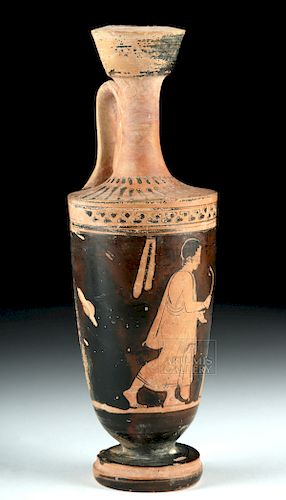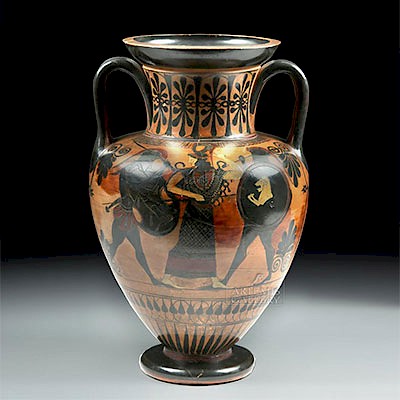Greek Attic Pottery Red Figure Lekythos - Boy & Strigil
Lot 10e
About Seller
Artemis Gallery
686 S Taylor Ave, Ste 106
Louisville, CO 80027
United States
Selling antiquities, ancient and ethnographic art online since 1993, Artemis Gallery specializes in Classical Antiquities (Egyptian, Greek, Roman, Near Eastern), Asian, Pre-Columbian, African / Tribal / Oceanographic art. Our extensive inventory includes pottery, stone, metal, wood, glass and textil...Read more
Estimate:
$2,000 - $3,000
Absentee vs Live bid
Two ways to bid:
- Leave a max absentee bid and the platform will bid on your behalf up to your maximum bid during the live auction.
- Bid live during the auction and your bids will be submitted real-time to the auctioneer.
Bid Increments
| Price | Bid Increment |
|---|---|
| $0 | $25 |
| $300 | $50 |
| $1,000 | $100 |
| $2,000 | $250 |
| $5,000 | $500 |
| $10,000 | $1,000 |
| $20,000 | $2,500 |
| $50,000 | $5,000 |
| $100,000 | $10,000 |
| $200,000 | $20,000 |
About Auction
By Artemis Gallery
Oct 11, 2018
Set Reminder
2018-10-11 10:00:00
2018-10-11 10:00:00
America/New_York
Bidsquare
Bidsquare : Exceptional Antiquities | Ethnographic Art
https://www.bidsquare.com/auctions/artemis-gallery/exceptional-antiquities-ethnographic-art-3500
An important one-day auction featuring museum-worthy examples of classical antiquities, ancient and ethnographic art from cultures encompassing the globe. Artemis Gallery info@artemisgallery.com
An important one-day auction featuring museum-worthy examples of classical antiquities, ancient and ethnographic art from cultures encompassing the globe. Artemis Gallery info@artemisgallery.com
- Lot Description
Greece, Athens (Attic), ca. late 6th to early 5th century BCE. A beautiful wheel-thrown pottery lekythos, finely decorated via the red-figure technique. The vessel is defined by a tiered discoid foot, a cylindrical body with a planar shoulder, a tapered tubular neck, a thick rim, and an applied strap handle joining neck to shoulder. The iconographic program features a right-facing youthful male wearing a flowing chiton, his left leg extended and his body with a slight forward lean, with his left hand empty and upturned and holding a curved strigil in his right. A register of enclosed oscillating dots courses around the upper body, and a ring of tongues radiates outward from the neck base. Lustrous black glaze with some faint patina covers parts of the foot and handle, the majority of the body, and much of the spout save for the upper rim. Size: 2.5" W x 7.55" H (6.4 cm x 19.2 cm).
The strigil was a scraper used in combination with olive oil and sand or pumice to exfoliate the skin after exercising or bathing. It was an essential piece of equipment for the typical Greek and Roman athlete, and as such came to symbolize athleticism itself. Greek cases abound with depictions of youthful athletes using strigils in the gymnasium. The celebrated sculpture by Lysippos, the Apoxyomenos of ca. 350 to 325 BCE, depicted a nude athlete scraping himself off with a strigil. The youth depicted in this scene may be headed to the bath houses, perhaps after a rigorous training session, or away if he had just finished bathing.
Provenance: private East Coast, USA collection; ex-Richard Wagner collection, Cape Cod, Massachusetts, USA, acquired in the 1970s
All items legal to buy/sell under U.S. Statute covering cultural patrimony Code 2600, CHAPTER 14, and are guaranteed to be as described or your money back.
A Certificate of Authenticity will accompany all winning bids.
We ship worldwide and handle all shipping in-house for your convenience.
#139397Repair to area of handle with some small nicks and resurfacing along break lines. Surface wear and abrasions commensurate with age, minor chips and nicks to body, foot, shoulder, handle, and rim, fading to some finer details on figure, and minor lightening to black-glazed areas. Light earthen deposits throughout. Old inventory label beneath base.Condition
- Shipping Info
-
All shipping is handled in-house for your convenience. Your invoice from Artemis Gallery will include shipping calculation instructions. If in doubt, please inquire BEFORE bidding for estimated shipping costs for individual items.
-
- Buyer's Premium



 EUR
EUR CAD
CAD AUD
AUD GBP
GBP MXN
MXN HKD
HKD CNY
CNY MYR
MYR SEK
SEK SGD
SGD CHF
CHF THB
THB
















